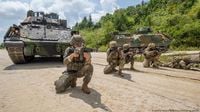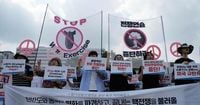On Monday, August 18, 2025, South Korea and the United States launched their annual large-scale joint military exercise, Ulchi Freedom Shield, in a climate of heightened uncertainty and regional tension. The 11-day exercise, running until August 28, is designed to bolster readiness against potential threats from North Korea, whose government has denounced the drills as provocative and warned of possible retaliation.
The Ulchi Freedom Shield exercise, a centerpiece of the allies’ security cooperation, involves approximately 21,000 soldiers, with about 18,000 from South Korea and a similar but undisclosed number from the United States, according to South Korea’s Joint Chiefs of Staff. Troops are participating in both live field training and computer-simulated command post operations, reflecting the complexity and seriousness of the security environment on the Korean Peninsula. As reported by Yonhap and other outlets, the scale of this year’s exercise matches last year’s, despite notable adjustments in scheduling.
The drills, described by both Seoul and Washington as defensive, have been a perennial flashpoint in regional politics. North Korea, led by Kim Jong Un, has long portrayed such exercises as rehearsals for invasion. In a statement last week, North Korean Defense Minister No Kwang Chol accused the allies of a “stance of military confrontation” and declared that North Korean forces would be ready to counteract “any provocation going beyond the boundary line.” The North has a history of responding to these exercises with military demonstrations, including missile tests and, as seen in 2023, a simulated “tactical nuclear attack” drill.
This year’s Ulchi Freedom Shield comes at a particularly sensitive moment for South Korea’s new president, Lee Jae Myung, who is preparing for a summit with U.S. President Donald Trump in Washington on August 25. The summit looms large over the exercise, as Trump has repeatedly called for South Korea to increase its financial contributions for the 28,500 American troops stationed on the peninsula. According to the Associated Press, Trump administration officials, including Undersecretary of Defense Elbridge Colby, have signaled a possible restructuring of the decades-old alliance, with suggestions that the U.S. might reduce its military presence as it pivots strategic focus toward China. This has fueled anxiety in Seoul about the future of the alliance and the balance of security responsibilities.
President Lee, who took office in June, has been walking a diplomatic tightrope. On one hand, he has called for “steady steps toward easing tensions, grounded in a firmly maintained state of ironclad security readiness,” as he told his Cabinet on Monday, according to the Korea Herald. On the other, he faces a North Korean regime that has rebuffed his overtures for renewed dialogue, accelerated its weapons development, and deepened military ties with Russia. Notably, North Korea’s alignment with Moscow has included sending troops to the Ukrainian front, further complicating the regional security calculus.
In an attempt to thaw relations, President Lee ordered his Cabinet to begin preparing a partial step-by-step implementation of existing agreements with North Korea, aiming to reduce tensions. While he did not specify which agreements would be prioritized, Lee has previously expressed a desire to restore the 2018 inter-Korean military agreement, which had established buffer zones and no-fly areas to prevent clashes along the border. That agreement was suspended in 2024 after a series of provocations, including North Korea’s launch of trash-laden balloons into the South and the resumption of frontline military activities by both sides.
The South Korean Defense Ministry clarified on Monday that there are no immediate plans to suspend live-fire training near the disputed western maritime border, despite these diplomatic gestures. Meanwhile, half of the originally planned 44 field training exercises for Ulchi Freedom Shield have been postponed to September, with U.S. military officials attributing the decision to extreme heat and flood damage at some training sites. Observers, however, suggest the postponement may also reflect the Lee administration’s efforts to create space for dialogue with Pyongyang. Still, as Hong Min, a senior researcher at the Korea Institute for National Unification, told the Korea Herald, “Although a part of the South Korea-US joint drill has been postponed, the exercise’s overall scale has been maintained, so there is nothing for North Korea to be particularly pleased about.”
North Korea’s response to the drills has been characteristically sharp, but as of Monday noon, Pyongyang had not taken any overt military action. Kim Yo-jong, the influential sister of Kim Jong Un, dismissed the exercise adjustments as “not deserving of praise” and reiterated the North’s lack of interest in reviving talks with Seoul. Historically, North Korea’s reactions to such drills have ranged from immediate missile launches to delayed, more muted provocations such as artillery exercises or public denunciations.
Beyond the military maneuvers, South Korea also kicked off a four-day nationwide civil defense drill on Monday, mobilizing about 580,000 people from 4,000 institutions. This annual Ulchi civil defense drill, running alongside the military exercises, is intended to strengthen national emergency preparedness and includes air raid evacuation drills and exercises to secure emergency vehicle passage. The presidential office in Seoul emphasized that the Ulchi drill is “intended to protect the lives and safety of the people, and not to heighten tensions on the Korean Peninsula.” The government has promised an objective evaluation of this year’s drill to inform improvements for next year, underscoring the importance of public safety and peace.
General Xavier Brunson, commander of U.S. Forces Korea, highlighted the need to “modernize” the alliance to address evolving security challenges, including North Korea’s nuclear ambitions, its growing ties with Russia, and what he described as Chinese threats to a “free and open Indo-Pacific.” The message from both militaries is clear: the alliance must adapt to a rapidly changing strategic environment while maintaining a credible deterrent against North Korean aggression.
For South Korea, the stakes are high. President Lee’s administration is under pressure to demonstrate both resolve and flexibility—balancing the need for robust defense with the pursuit of diplomatic openings. As Lee stated, “Relations between South and North Korea are crucial in order to protect the national interests of South Korea and expand the space to operate diplomatically in the face of rapidly changing external conditions.”
As the Ulchi Freedom Shield exercise unfolds over the coming days, all eyes will be on the Korean Peninsula. The world waits to see whether the drills will pass with relative calm or provoke another cycle of escalation, and whether President Lee’s gamble on a dual track of strength and engagement will yield progress—or more of the same old stalemate.





